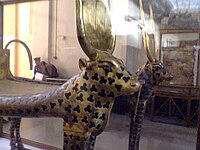Mehet-weret
| Mehet-weret in hieroglyphics | ||||||||
|---|---|---|---|---|---|---|---|---|
| Old empire |
|
|||||||
| Middle realm |
|
|||||||
| New kingdom |
|
|||||||
| Gr.-Roman. time |
Mehet-weret Mḥ.t-wr.t The great northern waters |
|||||||
| Greek |
Methyer ( Μεθύερ ) |
|||||||
|
Mehet-weret, ritual bed from the tomb of Tutankhamun Egyptian Museum Cairo (JE 62013) |
||||||||
Mehet-weret, as the ancient Egyptian goddess of heaven, birth and death, is already well documented in the Old Kingdom and is also mentioned as Mehet-ageb ("The water flood ") at that time. The goddess is represented exclusively in the form of a cow.
background
Old empire
In the early Old Kingdom, Mehet-weret was considered the mother of Horus and, associated with that, the mother of the king ( Pharaoh ) who emerged from her. In the early performances after his death and the subsequent transition to the Duat , the late king entered the area of the Mehet-weret in order to judge the warring deities Horus and Seth . The motif of judging between Horus and Seth also appeared in parallel in the pyramid texts .
The same symbolism was transferred to the deceased in particular in the New Kingdom , who during his resuscitation after the completed mouth opening ritual first had to judge the warring gods Horus and Seth as part of the solution , and then on the way to the " field of rushes " in Ta-djeser (Lichtland in der Duat ) to pass further examinations before the judgment of the dead .
Middle realm
In the Middle Kingdom , mythological changes in role allocation can be seen. Mehet-weret personifies the face of the deceased. Horus is located in the Duat and was given the name Horus-Duati ("Horus of the world beyond"). The cult of the sun god Re, which has been established since the 6th dynasty , now identifies Mehet-weret as the “mother of Re”, who is also considered to be the “great northern heavenly water” as the opposite image of the eye of Re . If Horus emerged from Mehet-weret in the old kingdom, it is now Re.
New kingdom
At the beginning of the New Kingdom, another change in Mehet-weret can be seen. Your task is to rejuvenate the aging king; similar to Re's rejuvenation theology in connection with the daily rebirth in the morning. Mehet-weret performs the functions of the groove and is understood as the great vault of the sky that houses the stars and ensures their well-being.
Mythological connections
She bears great resemblance to Hathor , with whom she was later associated. As the goddess of the “great flood”, Mehet-weret is closely associated with Neith . In the shape of a cow, she gives birth to the sun and places it between her horns. It symbolizes the primal waters from which the sun god emerges or the vault of heaven that carries the sun. By Plutarch ( De Iside et Osiride , Ch. 56), it was with Isis equated, or the celestial Isis Mehet.
See also
literature
- Hans Bonnet : Methyer . in: Lexicon of Egyptian Religious History . Hamburg 2000, ISBN 3-937872-08-6 , p. 459.
- Christian Leitz u. a .: Lexicon of the Egyptian gods and names of gods . Peeters, Leuven 2002, ISBN 90-429-1148-4 , pp. 375-376.
- Richard H. Wilkinson : The world of the gods in ancient Egypt. Faith - Power - Mythology. Theiss, Stuttgart 2003, ISBN 3-8062-1819-6 , p. 174.
